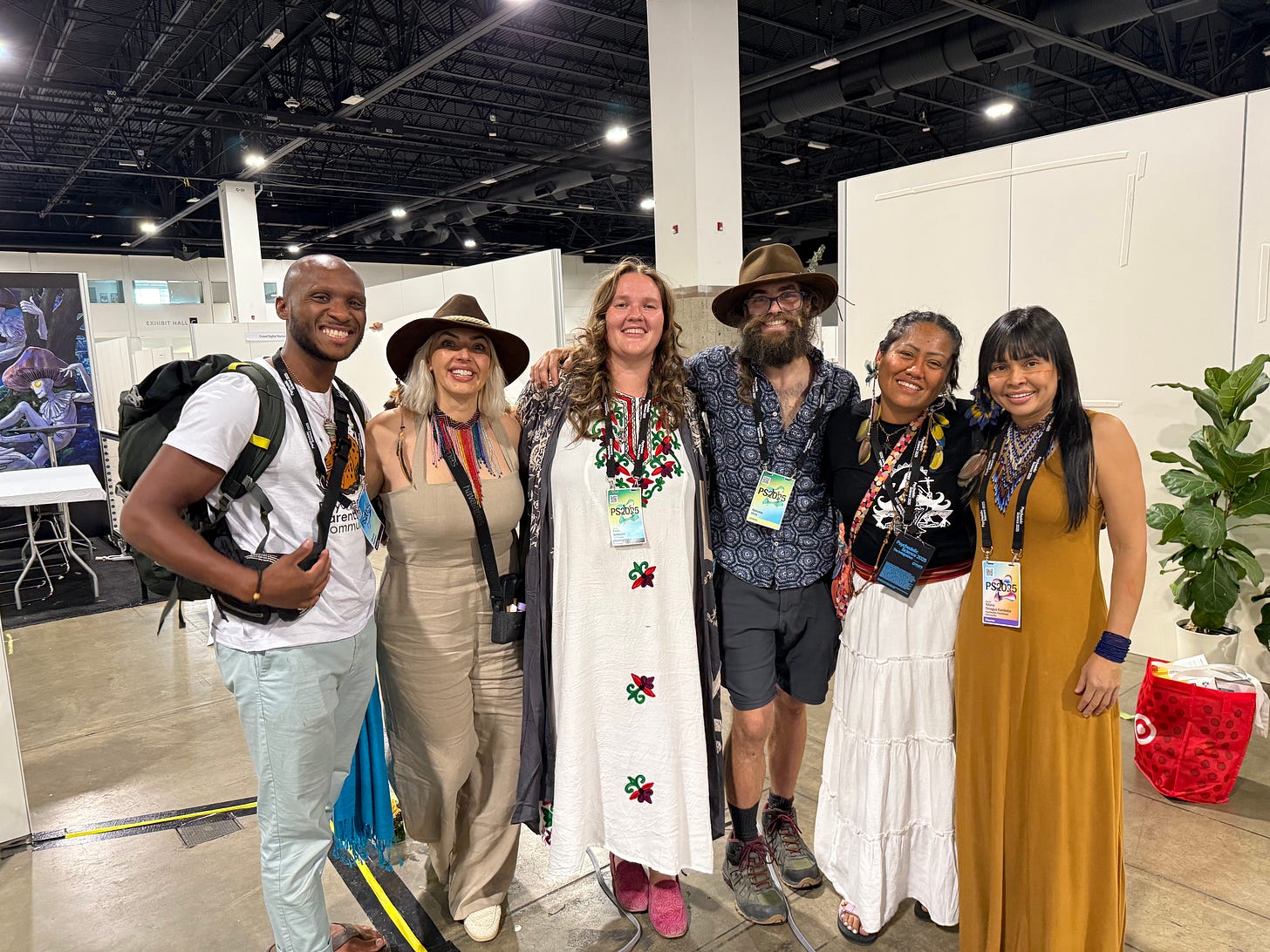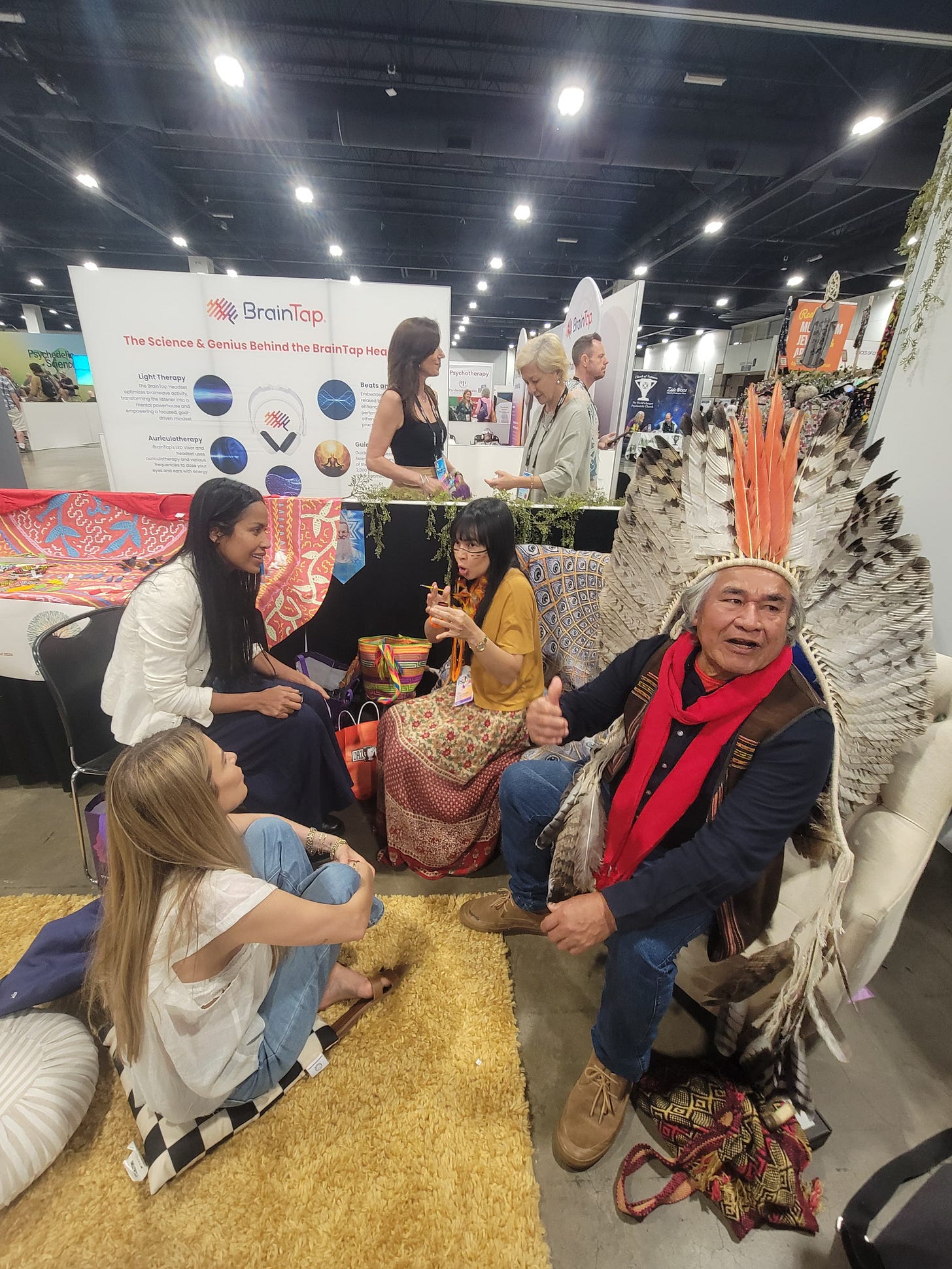A few days ago, I found myself sitting on the floor of a massive conference hall in Denver. There were no PowerPoint slides, no hierarchy, no corporate script. Just me, a group of volunteers from all over the world, two Indigenous elders from the Brazilian Amazon, and a Daime (Brazil Ayahuasca Church) Leader from Brazil connecting us all. We were sitting in a circle, catching our breath after holding space for dozens of people in a sacred rapéh ceremony. There was laughter. There were tears. There was a kind of magic that no marketing campaign could ever manufacture.
And I thought, This is the future of work.
From Ad Agencies to Ayahuasca Circles
For most of my career, I’ve worked in American corporations, navigating the world of advertising budgets, strategy decks, “targets,” and KPIs. But over the past three years, I’ve also been walking another path: studying Neuroscience and Education at Columbia University, co-founding community-based wellness events, and supporting Indigenous leaders from the Huni Kuin, Yawanawá, Kambeba, and Yepá Mansã nations in Brazil.
It’s a strange dual existence: one foot in high-performance capitalism, the other in ancestral knowledge systems that don’t even recognize time the same way.
But the bridge between these two worlds, I’ve realized, is TRUST.
Trust Is the New Strategy
In advertising, we use the concept of targeting: reaching the right person at the right time with the right message. It’s all about engineering trust—creating emotional resonance so people believe in a brand enough to buy something.
But in the brain, trust isn’t just an idea—it’s a neurobiological process. When we feel safe, our prefrontal cortex quiets the fear signals of the amygdala, and we release oxytocin, the hormone that promotes bonding. Trust arises when there is vulnerability, safety, and authenticity. And where there is trust, there is engagement, action, and a sense of belonging.
That’s not just neuroscience. That’s also ancient knowledge.
A Booth with No Plan
A few weeks ago, my dear friend @Glauber Loures de Assis, co-founder of the Psychedelic Parenthood Community and a Santo Daime spiritual leader, invited me to volunteer at Psychedelic Science 2025 in Colorado, sponsored by MAPS —one of the world’s largest gatherings on psychedelic research, spirituality, culture, arts, healing.
He said: “We need help at the booth.”
What he didn’t say was:
There would be no roles defined.
No schedule.
No script.
No furniture.
Instead, in true Brazilian ancestral freestyle, a WhatsApp group became our planning tool. Local folks brought pillows and plants. Others flew in with blankets and sacred objects. Someone got an altar cloth. Someone else printed photos of Padrinho Sebastião, Padrinho Irineu, and Madrinha Rita, all founders of Daime. Glauber brought an idea and the medicines. We brought the love.
And together, we created not just a conference booth, but a living organism.
Indigenous Leadership in Action
This year, Glauber invited two elders from Brazil who transformed the space:
Álvaro Tukano, a Doethiro (highest spiritual chief) of the Yepá Mansã people, was responsible for Indigenous land protections in Brazil’s 1988 constitution.
Dr. Adana Amagua Kambeba, a medical doctor and shaman from the Amazon River, is one of the first Indigenous women in Brazil to graduate from medical school.
They weren’t there for PR, although they were speakers at the conference. They were there for spiritual work. Álvaro reminded us again and again:
“This is high-level spiritual work. This is spiritual diplomacy.”
We didn’t need a plan because we had presence. We didn’t need structure because we had spirit. And every person who walked into that booth felt it.
Joy as a Technology
I worked 12+ hours a day. My feet hurt. My voice was gone. But I felt more energized than I ever have in any “high-stakes” corporate moment.
Why?
Because joy was the fuel.
Because I trusted the people around me.
Because no one was performing, everyone was contributing.
The only "target" we had was: talk to people. Be yourself. Tell them about the retreats. Add names to the list. That was it. But it worked. Better than any deck, better than any funnel, than any project plan could ever predict.
What If the Future of Work Is Sacred?
In corporations, we often discuss optimization, scaling, and efficiency. But after this experience, I’m left wondering:
What if the future of work is built not on performance—but on presence?
Not on hierarchy—but on circle?
Not on structure—but on spirit?
I’ve seen now, in real time, what happens when people are trusted. They become more generous, more creative, more joyful. They stay after their shifts. They show up early. They want to be there.
And that is what Indigenous leadership models already understand:
You are not here to execute. You are here to belong.
A Final Reflection
When trust leads, everything else falls into place.
And that’s the power of WE.
It can’t be strategized into existence. It must be created with courage, openness, and belief in one another, in the process, in something bigger.
I’m still in awe of what we created. And I’m still holding the question:
What would the workplace look like if we built it the way we built that booth?
With trust. With joy. With love.
Maybe that’s the real future of work.








Thank you for sharing